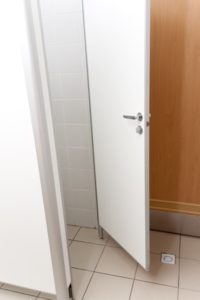It’s a familiar scene in any retail apparel store: A potential customer walks through the door or into a department, perhaps because a display item caught their eye, or maybe as a result of online research they completed before coming to the store. They look more closely at the item, check the price, and then start looking for their size. The sales associate approaches and asks, “Can I help you find anything?”
This is just one of the many opportunities to encourage the try-on. At that moment, the sales associate will hear either “No thanks, I’m just looking.” or “Yes, do you have this shirt in a medium?” By getting them in the door you are ahead of the game; however, there are many more chances for that shopper to walk away empty-handed.
[Tweet “How to Increase Retail Apparel Conversion: Turning Shoppers Into Customers”]
But you already knew that, didn’t you? To drive sales, we need to answer these questions:
- How can we convert that prospect from someone who is “just looking” into a paying customer?
- What strategies do successful, top-tier retailers employ to keep prospects in the store until they make a final purchase decision?
In most cases, a relatively serious sales floor shopper will find their size and head for the fitting room to see how that medium-sized shirt fits them.
[xyz-ihs snippet=”TOFU-Try-It-On-Button”]
What Do Your Fitting Rooms Say to Customers?
It’s important to put yourself in the shoes of your customers. When your customer walks into the store and sees an item that interests them, what happens next? In most cases, a relatively serious sales floor shopper will find their size and head for the fitting room to see how that medium-sized shirt fits them.
 Unfortunately when they get to the fitting rooms, they often find them with a not-so-fresh coat of paint, scuffed walls, and unflattering fluorescent lighting. (Some of those rooms could make Gisele Bundchen look lousy!)
Unfortunately when they get to the fitting rooms, they often find them with a not-so-fresh coat of paint, scuffed walls, and unflattering fluorescent lighting. (Some of those rooms could make Gisele Bundchen look lousy!)
Even worse, the fitting room scene is unorganized and chaotic and there are two or three people waiting ahead of them for the “privilege” of trying on clothes in cramped conditions.
The shopper faces a difficult choice:
- Do they wait their turn, and risk being late getting back to work after lunch?
- Do they buy it anyway and hope that it fits and looks as sharp as they think it will?
- Or, do they just put the item down and head to the food court for a quick lunch?
What would you do in their shoes? When faced with this dilemma, a lot of shoppers will choose option three. For the retailer…One more opportunity wasted!
The Shopper Who Tries is More Likely to Become the Shopper Who Buys
When online shopping first started taking off, retailers were afraid that this would diminish the bricks and mortar retail business. But for apparel that hasn’t happened. The ability to “try before you buy” is unique to the in-store shopping experience, and necessary for the final buying decision.
Online retailers are so threatened by this simple fact, they’re developing sophisticated modeling technology in the hope that “virtually” trying on clothes will help drive online sales.
However, the technology is far from perfect. Online return rates due to fit are around 70%! This – combined with the personalized experience that can only happen on the sales floor – gives bricks and mortar retailers the upper hand.
[Tweet “Online apparel return rates due to fit are around 70%!”]
We know that customers must try-on merchandise, especially clothing, before they make their final decision. Some will buy the item without trying it on in the store, returning it later if they don’t love it. Returns are a nuisance for the client, a pain for the sales associates who have to spend time processing them instead of helping other customers, and they’re bad for the store’s bottom line.
It’s much better for all involved if shoppers try garments on while they’re still in the store. So why, then, do we force customers to try-on clothing in spaces that are, at best, an afterthought in many retail floor plans? This is a real person, in your store, hoping to make a purchase, and all too often the part of the customer’s journey that should be the simplest becomes the most complicated.
[xyz-ihs snippet=”TOFU-Try-It-On-Button”]
The Fitting Room is Where Shoppers Become Customers
A lot of retailers are under the impression that a retail transaction happens at the cashwrap.
Not so!
 When a customer can try-on clothes in a secure, comfortable, and inviting atmosphere with helpful, attuned sales associates at the ready, they are more likely to make a purchase. In fact, once a customer has made it into the fitting room, the likelihood of converting the sale jumps from 10% to 67%! Better still, those who have tried on clothes in a well designed environment have dramatically fewer returns.
When a customer can try-on clothes in a secure, comfortable, and inviting atmosphere with helpful, attuned sales associates at the ready, they are more likely to make a purchase. In fact, once a customer has made it into the fitting room, the likelihood of converting the sale jumps from 10% to 67%! Better still, those who have tried on clothes in a well designed environment have dramatically fewer returns.
Designing an apparel store with focus on the fitting room improves the customer experience and drives sales. Having a sales associate simply ask “Can I start a fitting room for you?” early on helps steer customers to the next step in the purchase phase. Ensuring the sales associate engages the customer by offering to help with different sizes, colors, or styling keeps the client in the fitting room at the moment they are making the ultimate purchase decision.
There is a reason so many top-tier retailers have invested heavily in the design, service, and technology for their fitting rooms. They know that trying on apparel is the real moment of truth in the purchasing process.
Bottom line – There are many reasons why a shopping experience can end without a sale. Make sure access to an inviting fitting room isn’t one of them!
[xyz-ihs snippet=”Try-It-On-CTA”]
